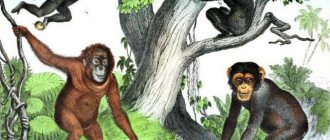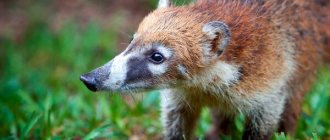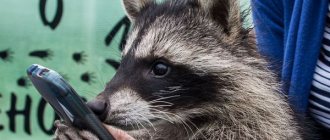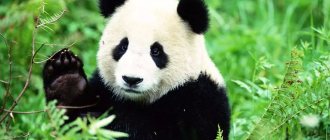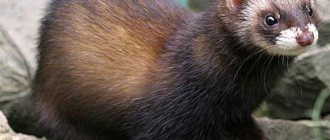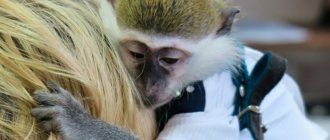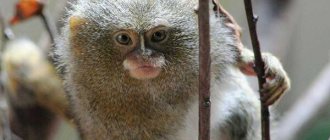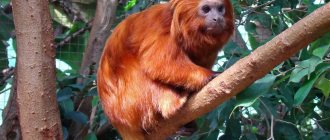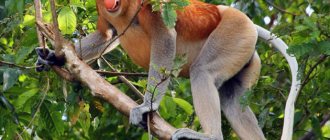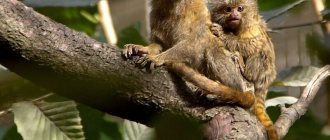- Wild animals
- >>
- Mammals
The monkey is a small, very playful and funny animal. Distinctive features are the animal’s intelligence and incredible sociability. Often these animals are used as heroes of circus shows, as they willingly make contact with humans and are quite easy to train. The monkey has a small body size and is a representative of the monkey family. This family includes a large number of species of small monkeys.
Origin of the species and description
Photo: Monkey
Monkeys belong to chordate mammals, classified into the order Primates, family Marmosetaceae, genus Marmoset. Monkeys are considered the creatures most closely related to humans. The theory of their origin and evolution goes back many centuries and even millennia. Scientists have proven that the DNA of humans and monkeys has more than 80% similarity. A more detailed study of DNA showed that the evolutionary process of apes and humans diverged approximately 6.5 million years ago.
According to scientists, the first and very distant ancestors of modern monkeys appeared on earth in the Cenozoic era. This happened approximately 66 million years ago. The first monkeys ate exclusively insects, grubs and worms and lived in the crowns of tall trees. The most ancient ancestors of modern apes were called ancient lemurs. They gave rise to many species of primates.
Video: Monkey
Numerous fossil finds discovered by archaeologists indicate that the first representatives of primates appeared on the territory of modern Egypt. This region contained vast wet, tropical forests, which provided an ideal habitat for these animals.
The ancient ancestors of modern monkeys became the ancestors of such species of monkeys as Gigantopithecus. They were enormous in size and not distinguished by their agility and intelligence. The body dimensions of some individuals exceeded three meters. As a result of changing climatic conditions and cooling, most of them died out. However, they gave rise to dryopithecines, which had smaller body dimensions and were distinguished by a more playful character and intelligence. Scientists call this species of ancient primates the earliest representatives of this species, which are as close as possible to modern species.
Why not every monkey can be called a monkey
Category: Animals
Among the monkeys of the Old World, the most numerous and diverse is the family of the lower narrow-nosed monkeys, or monkeys. For some reason, it has become the custom that the word “monkey” is often used instead of the word “monkey.” This is not true. Because monkeys are a special kind of monkey.
The genus of monkeys is diverse. According to some experts, there are twenty-one species of monkeys. According to others, there are twenty-three species. There are all sorts of monkeys in the world. There are green and blue monkeys, mustachioed monkeys and forelock monkeys, white-nosed and red-tailed monkeys, blue-faced and black-eared monkeys, long-eared and bearded monkeys. And many other species, subspecies and varieties.
All monkeys are indigenous to Africa. They live in forests. They live in trees. Each species has its own habitat.
Monkeys are fast, light, agile creatures. They have a slender body and a long, non-prehensile tail, a round head, a short muzzle, and a nose that does not protrude far beyond the face. All marmosets have calluses and cheek pouches. The bags are quite spacious, so that when the monkey fills them tightly with maize grains during a raid on a plantation, for example, its head seems twice as large. Two small, black calluses separated by a strip of fur. This is a distinctive feature of monkeys.
Brass's monkey.
Another distinctive feature is that the females’ nipples are located so close to each other that the nursing calf can grab both of them with his mouth at once. A monkey usually gives birth to one baby.
The dexterous hands and feet of monkeys covered with short fur are equipped with five almost human-shaped fingers, and the fingers have neat flat nails. All monkeys have 32 teeth. The most common colors are green, green-gray, yellow-green, and olive tones. Many species have black spots at the end of the tail or on the top of the head. Black soles and a black face are also not uncommon, as are bright spots, stripes, mustaches, sideburns, and tufts of hair.
The frivolously named gwyret monkey, for example, has long white tufts of hair sticking out from its cheeks. Vervet monkeys are greenish, and the fur on their back at the base of their tail is red.
The beautiful Mona monkey has a reddish-brown upper body, a white chest, abdomen and the insides of the arms and legs, and two white spots at the base of the tail. The face has yellow brow stripes and yellow cheek tufts of hair on the cheeks.
But the beauty of beauties is Diana the monkey. She has a black face and a white beard. A bluish cap on the head. Greenish coat, the color of which turns purple-brown on the back. Imagine these colors in combination with a dazzling white shirtfront, add cream shades of the abdomen, orange-brown fur on the hips, top it all off with white stripes on the sides, and you will agree that there is no monkey in the world more beautiful than Diana.
Green monkeys were not particularly flamboyant in color. But the white mustache and sideburns on the black faces also gave them a picturesque appearance.
Green monkeys live in the forests of Ethiopia. Here they are found everywhere in areas located at an altitude of one thousand to two thousand meters above sea level, in forests, in dense treetops. They are almost invisible among the foliage in their greenish outfits. They are also well camouflaged on the ground, where they regularly go down to drink and rob. Robbery raids of green monkeys on plantations are a true disaster for the local population.
Green monkey.
Not only green ones, but essentially all monkeys are inhabitants of the highlands. The forests in which they are found are located, as a rule, at an altitude of up to three thousand meters. Monkeys feed on leaves, young shoots, and maize grains, if they can get them on the nearest plantation. They usually live in large herds of forty to fifty monkeys.
Appearance and features
Photo: What a monkey looks like
Marmosets are considered to be fairly small monkeys. Their body length ranges from 30 to 100 centimeters. In these animals, sexual dimorphism is not significantly expressed. Males have larger body sizes than females. Depending on the species, some of its representatives may have an enviable, long and thin tail, while others may not have it at all. The length of the tail in some species exceeds the length of its own body and reaches one meter or more.
Body type also depends on the species. It can be thin and elongated, or it can be massive and stocky. The back of the limb is always somewhat shorter than the forelimbs. Just like humans, their hands are smaller than their feet. It is noteworthy that the hands are quite developed and the monkeys deftly wield them like hands. Each finger of the hand has a flattened nail plate. The thumb, just like in humans, is different from all the others. In those monkeys that have a massive, stocky body, the thumb is not very developed or is completely absent.
The shape and size of the head also depends on the species. It can be small or large, elongated, round, or triangular in shape. The facial part is most often elongated, the nostrils are located in close proximity to each other. The eyes can be deep-set, large and very expressive.
Most species of monkeys have fairly long and silky fur, but not as thick as other monkey species. The color can be very diverse, depending on the subspecies: gray, brown, greenish, blue, black, brown, etc. The fur covers almost the entire body, with the exception of the soles of the feet, the front of the head, and the ischial part. Some species have no fur in the chest area. It is noteworthy that monkeys have a jaw structure similar to humans. They have an almost identical shape of teeth, and their number is 32. Marmosets are distinguished by a very developed brain and a complex stomach structure.
Monkey: description
Marmosets represent chordate mammals, the order Primates, the family Marmosetaceae, and the genus of the same name. According to experts, monkeys represent the creatures most closely related to humans, so there is a theory of origin that goes back several thousand years. The theory is also confirmed by the fact that the DNA of monkeys and humans is 80 percent similar. Scientists believe that the process of evolution of humans and monkeys went in different directions about 6 and a half million years ago.
As experts point out, the first monkeys appeared on our Planet back in the Cenozoic era, and this is neither more nor less - about 60 million years ago. Their diet included insects and their larvae, as well as various worms, and they lived in the crowns of trees that were huge at that time. The ancestors of modern monkeys were called ancient lemurs and they are considered the ancestors of modern primates.
Archaeologists were able to find numerous remains of similar animals in Egypt, which suggests that it was here that the first ancestors of modern monkeys appeared. In the past, dense forests with a humid tropical climate grew in Egypt, which provided a very comfortable habitat for these interesting mammals.
The ancestors of modern monkeys are considered the ancestors of many species of monkeys, including Gigantopithecus, which were characterized by very impressive sizes, although they were distinguished by unique agility and intelligence. Their body sizes reached 3, or even more, meters. Despite this, as a result of serious climate changes, these huge monkeys simply became extinct. And yet, thanks to these animals, another type of monkey saw the light - Dryopithecus, which was more advanced, although slightly smaller in size. This species, according to experts, is more suitable as the ancestor of modern representatives of this family.
Monkey interesting facts
Appearance and features
Marmosets are relatively small monkeys, with a body length from 30 cm to 1 meter. Sexual dimorphism is not clearly expressed, so it is very difficult to distinguish between a female and a male, although males are larger in size. Each species may differ in the presence or absence of a tail, as well as its size and thickness, while the length of the tail can be commensurate with the length of the body.
The body type can also vary significantly, as it can be thin and elongated, or it can be massive and stocky.
In these interesting animals, the hind limbs are always somewhat shorter than the front ones, and the hands, like those of humans, are always smaller compared to the feet. Monkeys have well-developed hands, so they control them just as well as their hands. Each finger of the hand has a flattened nail plate, while the thumb has some differences, just like in humans. In a species that is distinguished by a massive, stocky body, the thumb is much less developed, and in some species it is absent altogether.
The shape and size of the head also depends on the variety, so the head can be large or small, elongated, round or triangular in shape. As a rule, the facial area is characterized as elongated, with the nostrils located literally next to each other. The eyes can be deep-set, as well as large and quite expressive.
The nature of the coat of most species is relatively long and silky to the touch, although the thickness of the coat can vary significantly depending on the species, as well as the color of the coat, which can be gray, brown, greenish, blue, black, brown, etc. As a rule, the entire body of the animal is covered with hair, with the exception of the lower surfaces of the feet, the front part, and also the ischial part of the body. There are species that lack hair in the chest area. Interestingly, monkeys have a similar jaw structure to humans, while the shape of the teeth is the same as their number - 32. It is believed that the monkey’s brain is much better developed compared to other animals, and the structure of the stomach is no less complex.
Natural habitats
These mammals easily adapt to different living conditions.
In this regard, monkeys can be found in a wide variety of areas:
- In the mangroves.
- In swampy areas.
- In tropical rainforests.
- In the jungle.
- In the mountains and also on hilly areas.
- On plains, in open areas, in the valleys of large rivers.
Based on geographical regions, the habitat of monkeys is associated with the African continent, except Madagascar, with the central and southern regions of North and South America, including Australia.
Monkeys are considered highly social species of animals, so they tend to form groups of varying sizes. They prefer to lead a sedentary lifestyle, so they live in the same territory for many years. There are 3 categories of such animals: arboreal, which spend almost their entire lives in the crowns of large trees, terrestrial, which prefer to live and feed on the surface of the earth, as well as mixed ones, which feel equally comfortable both on the ground and at height, on branches trees.
Monkeys spend the night, depending on their habitat conditions: some scavenge from the dense crowns of spreading tropical plants, while others choose caves, gorges, and other places for reliable shelter from natural enemies. Adults take care not only of themselves, but also of their growing offspring.
What does it eat?
Depending on the species, monkeys are either omnivores or herbivores, and the diet of such animals is largely formed depending on their habitat.
As food, monkeys eat:
- Various fresh fruits.
- Young shoots of various vegetation.
- Leaves.
- Seeds of various plants.
- Inflorescences.
- Buds.
- Mushrooms.
- Larvae of various insects.
- Nuts.
- Small insects.
Some subspecies feed on a wider range of beetles, worms, spiders, caterpillars, small reptiles, freshwater animals, etc. At the same time, they can hunt small birds, destroying their nests and eating eggs or chicks. Monkeys rarely appear at watering places, since they fill their bodies with liquid from succulent shoots, as well as the fruits of various plants.
The forelimbs of monkeys have the highest functionality. With their help, monkeys pluck food items for themselves, and also move from branch to branch, as well as from tree to tree. Some species consume only about 30 percent plant food, with the remaining 70 percent being protein foods of animal origin. When the rainy season approaches, which is typical for the tropics, monkeys have a hard time with plant food, since during this period berries, fruits, nuts, etc. have not yet ripened, so they have to eat seed material. Adults eat up to 3 kilograms of food of various origins per day.
Behavior and lifestyle
Small monkeys have a well-developed brain, so their chances of survival in such difficult conditions are quite high. This allows them to easily adapt to any living conditions. Unfortunately, their sense of smell is poorly developed compared to other mammal species.
Little monkeys are distinguished by a very sociable and friendly disposition towards humans; in addition, they are very curious creatures. Most species lead a mixed lifestyle, thriving on the surface of the earth, as well as in the crowns of trees. They are predominantly diurnal, preferring to rest at night. They do not lead an isolated lifestyle and prefer to stay in groups of several dozen individuals, although there are groups whose number is 100 individuals, and sometimes more. Each group is characterized by the presence of a male leader.
By their nature, monkeys do not show aggression, either towards humans or towards their neighbors, who represent other species of animals. An exception is the breeding season, when males provoke fights among themselves for the right to fertilize females.
The daytime period for monkeys is an opportunity not only to get food for themselves, but also to frolic, and also to look after each other. Caring for each other comes down to searching for various parasites that have managed to settle in the monkeys’ thick fur. Due to this, they manage to get rid of bloodsuckers, as well as maintain their coat in good condition.
With the onset of darkness, the monkeys rest, being in a secluded place where various predators cannot penetrate.
When communicating with each other, monkeys make all sorts of sounds that are aimed at communication, while by making certain sounds, they can warn their relatives about the approach of natural enemies, and also ask for help if they find themselves in danger.
Green monkeys - All about primates | Green monkey species
Social structure and reproduction
Depending on the species, sexual maturity of individuals occurs on average at 3-5 years of age. The mating season of these animals does not depend on the time of year and depends only on their readiness to mate, and therefore continues throughout the year. For the sake of fairness, it should be noted that there are species whose mating season is confined to a certain time of year, although there are very few such species.
As a rule, one of the most experienced and powerful males gets the right to fertilize females, and they arrange fights for the right to create a pair. After the fights, the males begin to court their potential mates. It can take a long time for the female to recognize her partner. The relationship process begins from the moment the female begins to clean the male’s fur.
After mating, the female begins to bear her future offspring for 6 months. As a rule, one cub is born, although there may be two, but this is extremely rare. A female can become pregnant 2 times in a year.
Monkeys generally give birth at night, choosing secluded places for this. After birth, the cub immediately tries to cling to the mother’s fur with its rather tenacious fingers. The female tries to support the newborn with her tail. It should be noted that baby monkeys are born helpless and weak, so their mother will have to make a lot of effort to produce her offspring. She feeds her offspring with milk for six months.
When the babies begin to quickly and deftly climb onto their mother’s back, she begins to go out with them on peculiar walks. From this moment, as they grow older, the mother teaches them to obtain food for themselves, as well as to hide from natural enemies. The mother also teaches the cubs the speed of movement in the treetops, as well as the nature of communication with their relatives.
Natural enemies of the monkey
Monkeys living in the natural environment have more than enough enemies, so it is not surprising that they climb trees deftly and high, which is due to the high tenacity of their limbs. Their intellectual abilities play an equally important role in ensuring their safety.
The enemies of monkeys are:
- Various predatory animals of the cat family.
- Various birds of prey.
- Ocelots.
- Various reptiles.
An equally dangerous enemy for monkeys is man, who, due to his vigorous life activity, drives monkeys out of their natural habitats.
Due to the increase in population, people are developing more and more new territories to feed themselves, cutting down forests, which leads to the destruction of the natural habitat of the monkeys. Forest plantations serve not only as a home for animals, but also as a dining room, where they can always find food for themselves. By cutting down forests, people deprive animals of both their home and food supply, which leads to a decrease in the total number of monkeys.
Due to the fact that monkeys are considered to be very inquisitive creatures by nature, this causes them mortal harm. A monkey can grab a poisonous snake or a poisonous spider, the bites of which can be fatal for monkeys. These animals are very sensitive to climate change, as well as to environmental pollution.
Where does the monkey live?
Photo: Monkey monkey
Monkeys adapt quite quickly to almost any living conditions.
In the natural environment, they can also inhabit a wide variety of territories:
- mangroves;
- marshy areas;
- tropical rainforests;
- jungle;
- mountainous or hilly areas;
- open areas, plains, or valleys of large rivers.
The main geographic regions inhabited by marmosets are the African continent, with the exception of Madagascar, the central and southern regions of North and South America, and Australia.
Monkeys tend to form groups of varying sizes. Each group occupies its own habitat. They tend to lead a sedentary lifestyle, and live most of it in one region. There are three categories of monkeys: arboreal, which spend most of their lives on the branches and crowns of tall trees, and terrestrial, which live and feed on the surface of the earth. There is also a mixed type of animals - they exist equally on tree branches and on the surface of the earth.
In addition to tall, spreading trees, caves, gorges, and other secluded places are often chosen as places to spend the night, which help to hide from predators and hide their babies from them until they get stronger and are ready to leave the shelter.
Now you know where the monkey lives. Let's see what she eats.
What does a monkey eat?
Photo: Monkey on a tree
By nature, monkeys are either omnivores or herbivores. The diet depends on the subspecies and region of habitat.
What serves as food for animals:
- fresh, juicy fruits;
- succulent shoots of green vegetation;
- foliage;
- seeds;
- inflorescences;
- buds of flower plants;
- larvae;
- mushrooms;
- nuts;
- small insects.
Some subspecies of monkeys can eat beetles, worms, spiders, caterpillars, small reptiles, freshwater reptiles, lizards, chameleons, etc. There are often representatives of individual subspecies that eat small birds and can drink their eggs. Monkeys practically do not go to watering places, since the body’s need for fluid is replenished with lush types of green vegetation and ripe fruits of fruit trees.
Monkeys most often pick up food with their forelimbs and use them as hands. Plant food in some subspecies makes up only 30-35% of the total daily diet. The rest of the food is replenished with protein and animal foods. In some regions where the rainy season begins, plant foods are difficult to obtain. During this period, there are practically no berries, fruits and nuts in forests and savannas. Then the main source of food for herbivorous species is seeds. On average, the daily food intake of one adult is from 1 to three kilograms of food.
Features of character and lifestyle
Photo: Monkeys
By nature, small monkeys are endowed with a very developed brain, which increases their chances of survival and allows them to adapt to almost any living conditions. Also, from birth they have a very poorly developed sense of smell.
The character of little monkeys is very sociable and friendly. By nature they are endowed with curiosity. The lifestyle of most species is mixed: terrestrial and arboreal. The vast majority of representatives of different species are diurnal monkeys. At night they tend to rest. It is unusual for monkeys, like all other species of primates, to lead a solitary lifestyle. They live in a group setting. The number of individuals in one such group can be varied: from 10 to 30 individuals. Some particularly large groups number about a hundred or more individuals. In each group there is a male individual who performs the functions of a leader, leader.
Monkeys by nature are calm, friendly and do not tend to show aggression towards representatives of their own or other species of animals. The exception is the breeding season, when males fight with each other for the right to create a pair with a female.
During the day, animals mainly get their own food and frolic. They spend a lot of time caring for each other's fur. Thus, they get rid of parasites and keep the coat clean and tidy. At night, monkeys mostly rest. They most often spend the night in caves, rock or mountain crevices, and the crowns of branchy trees.
Monkeys make various sounds as a means of communicating with each other. With their help, monkeys warn their relatives about possible danger, call each other for help, etc. It should be noted that the spectrum of sounds in monkeys is quite diverse.
Lifestyle of monkeys
Monkeys live in a variety of landscapes: mangrove swamps, jungles, rocky areas and open plains, and they can also climb mountains. The lifestyle of monkeys is terrestrial and arboreal. Almost all species of the marmoset family are diurnal monkeys.
Monkeys most often unite in groups, which can be quite large (50-100 individuals). During the breeding season, males fight among themselves for females.
Rufous-tailed monkey (Cercopithecus solatus).
Monkeys spend the night in caves or in trees. Marmosets are herbivorous or omnivorous monkeys. They can make a large number of sounds to communicate with each other.
Social structure and reproduction
Photo: Baby monkey
Female monkeys reach sexual maturity on average at the age of 3-5 years. This age may vary among representatives of different species. The mating season is most often not confined to any season and can occur all year round. However, in some subspecies it may be confined to a certain period, depending on the climatic conditions of the region of residence.
The strongest and most experienced male gets the right to create a pair with the female he likes. Sometimes males compete with each other for the right to create a pair. The male always courts a potential mate. She watches him for a while. If she likes him and is ready to create a pair with him, she brushes his fur. This is the beginning of a relationship.
After mating, pregnancy occurs. It lasts approximately six months. In most cases, one cub is born, extremely rarely two. Most representatives of the species bear offspring once every two years.
Childbirth most often occurs at night. Females go to trees, caves, or gorges to give birth. As soon as the baby is born, it begins to cling to the mother's fur with tenacious fingers. She holds him with her tail. Babies are born quite weak and helpless. The first months of life, females spend quite a lot of time and effort caring for their offspring. The period of breastfeeding lasts an average of six months.
When the babies get a little stronger, they learn to deftly and quickly climb onto their mother’s back. After this, the female gradually goes out with them on short, short walks. As the cubs grow and become stronger, females with them on their backs teach them how to search and obtain food, and also develop self-preservation skills in them. Mothers also devote quite a lot of time to teaching their babies tenacity, how quickly they can climb trees, and how to communicate with their relatives.
Upon reaching puberty, they leave their family and lead an independent, isolated lifestyle. The average life expectancy in natural conditions is 16-20 years.
More interesting facts about monkeys
Peak activity of monkeys almost always occurs during the daytime. Most monkeys are tree dwellers. Almost all species prefer to live in groups in which a complex system of social relationships is observed.
Nsungwepithecus is considered the fossil ancestor of the apes. His remains were found during excavations in Tanzania and, according to experts, date back to the mid-Oligocene. The remains of another ancient representative of this family, Victoriapithecus, were found in Kenya and belong to the Miocene, their age is about 20 million years.
The article was read by 3,975
Natural enemies of the monkey
Photo: What a monkey looks like
In their natural habitat, monkeys have quite a lot of enemies. What helps them survive is the ability to climb high in trees, and they can instantly climb great heights and are tenacious.
Enemies include:
- predatory representatives of the cat family - cheetahs, lions, jaguars, leopards;
- predatory species of large birds - eagles, stoats, harpies;
- ocelots;
- reptiles.
Humans can also be considered enemies of monkeys. His activities practically deprive them of their homes. Man kills foxes, destroying and destroying the monkeys' natural habitat. The development of ever new territories contributes to the reduction and impoverishment of the food supply, which also negatively affects the number of animals.
By nature, monkeys are very inquisitive and active animals. This often causes fatal harm to them. Monkeys can grab a dangerous snake or a poisonous spider, the bites of which are often fatal for small animals. Marmosets are also sensitive to changing climatic conditions and environmental pollution in the regions where they live.
